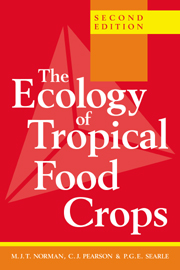8 - Pearl millet (Pennisetum glaucum)
Published online by Cambridge University Press: 05 June 2012
Summary
Taxonomy
The genus Pennisetum, of the subfamily Panicoideae, tribe Paniceae, comprises over 140 species in both the Old and New Worlds. The section Pennisetum of the genus includes two species: a perennial tetraploid forage plant, and an annual diploid species (2n=2x=14) representing both wild and cultivated forms of pearl millet (Brunken, 1977).
Brunken divided the diploid species, which at the time was known as P. americanum, into three subspecies: ssp. americanum, cultivated pearl millet; ssp. monodii, its wild relatives; and ssp. stenostachyum, weedy types intermediate between the other two species, called shibras in West Africa. Clayton & Renvoize (1986) showed that P. americanum was not a valid name for pearl millet, which is now termed P. glaucum (L.) R. Brown.
Cultivated pearl millet is morphologically and phenologically very diverse. Brunken, de Wet & Harlan (1977) recognised four races, characterised by the size and shape of the caryopsis and of the inflorescence as a whole:
typhoides, found across the whole range of cultivation in Africa and India.
nigritarum, dominant in the eastern Sahel.
globosum, dominant in the western Sahel.
leonis, dominant in coastal West Africa.
Phenology has also been used as a criterion for broad grouping into early, medium and late types; in West Africa the boundaries between these two groups are 95 and 130 days to maturity, in India 100 and 180 days (Purseglove, 1972).
The tetraploid forage plant P. purpureum, napier or elephant grass, may be crossed with pearl millet, and the resultant hybrid is in use as a forage (Muldoon & Pearson, 1979).
- Type
- Chapter
- Information
- The Ecology of Tropical Food Crops , pp. 164 - 182Publisher: Cambridge University PressPrint publication year: 1995
- 2
- Cited by



